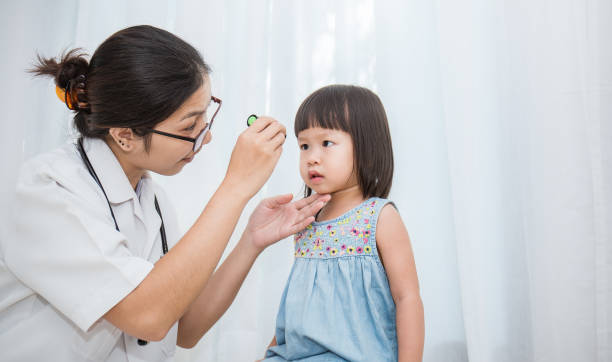
Did you know that according to the American Academy of Ophthalmology, 80% of a child’s learning during their first 12 years comes through their eyes? This highlights the importance of eye health for your child. Impaired or distorted vision can hinder their growth and development. This is why we advise regular examinations by an eye specialist.
Many eye-related problems in children can be cured or managed if detected early. By addressing these issues in their early stages, your child can avoid chronic eye problems later in life.
Recognizing the signs that indicate your child may need to see a children’s eye doctor can be challenging. To make things easier for you, we have compiled seven crucial signs that suggest your child should have their eyes examined by a paediatric eye specialist.
Common Pediatric Eye Conditions You Should Know About
Before we discuss the signs that indicate your child needs a comprehensive eye check-up from a kid’s eye doctor, let’s briefly mention some common paediatric eye conditions.
Refractive Errors:
Refractive errors are among the most prevalent paediatric eye problems. These errors occur when the size of the eye prevents light from converging at the retina, which contains specialized cells called photoreceptors responsible for detecting light. This leads to blurry vision, similar to looking through a hazy window.
Common refractive errors in children include:
- Myopia (Nearsightedness): Difficulty seeing distant objects.
- Hyperopia (Farsightedness): Difficulty seeing nearby objects.
- Astigmatism occurs when the cornea or lens has an irregular or abnormal shape, causing light to bend unevenly as it enters the eye. This results in a refractive error.
Astigmatism occurs when the cornea or lens has an irregular or abnormal shape, causing light to bend unevenly as it enters the eye. This results in a refractive error.
Recommendation:
Regular and thorough eye examinations by paediatric eye doctors can easily detect refractive errors in children. Following diagnosis, eyeglasses can be prescribed for children of all ages, and contact lenses may be an option for older children. In some cases, surgery may be necessary.
Amblyopia is a condition where a child’s eyesight doesn’t develop properly during childhood. It means that one or both of their eyes don’t see as well as they should. Around 3% of children may suffer from amblyopia, which is commonly called lazy eye because the stronger eye works better than the weaker one. This is because the brain favours the stronger eye and ignores the signals from the weaker eye. Left untreated for a long time, it can lead to permanent vision loss in the weaker eye.
Strabismus (Crossed Eyes or Squint)
Strabismus is a condition where the eyes do not align properly or look in the same direction. The six muscles around each eye work together to help both eyes focus on the same object.
However, these muscle movements are not properly coordinated in children with squint. This can cause the eyes to turn inward, outward, upward, or downward. As a result, one eye may focus on one object while the other eye turns in a different direction and focuses on another object. The misaligned eyes can cause double vision, or the brain may try to suppress the input from the misaligned eyes, leading to amblyopia.
A kid’s eye doctor can treat the eye with eye patches, eyeglasses, exercises, or surgery, depending on the severity and underlying cause of this paediatric eye condition.

stye is a common eye problem that resembles a boil on the eye. It occurs when the oil glands on the surface of the eyelids get blocked, creating a place where bacteria can grow. These bacteria thrive especially during damp and sweaty seasons. Styes, also known as hordeolums, often appear as a red lump on the eyelid. They can be uncomfortable and cause swelling, tenderness, and sometimes fluid coming out from the affected area.
An eye doctor may suggest that you apply a warm compress gently over the affected eye, and apply antibiotic ointments. In severe cases, a surgical procedure may be required.

Keratoconus is an eye condition that typically affects children in their teenage years or early adulthood. It involves thinning and bulging the cornea, the clear front part of the eye, resulting in a cone-like shape. This change causes blurry vision, double vision, nearsightedness, astigmatism, and sensitivity to light. It usually affects both eyes. In more severe cases, scarring or a circle may be seen within the cornea. Children with keratoconus often face difficulties in activities like sports and reading due to constantly changing visual obstacles.
If a child has keratoconus, they may frequently need to change their glasses. When they visit the eye doctor, the doctor will perform tests, including mapping the shape of the cornea, to assess the condition.
The treatment for keratoconus depends on how advanced it is. Eye specialists may recommend lenses or surgery to help align the eyes properly.

“Pink eye” or conjunctivitis is a condition that causes your eyes to appear pink or red due to inflammation of the conjunctiva, which is the thin, clear tissue that covers the inside of your eyelids and the white part of your eye.
Conjunctivitis can be contagious when germs like bacteria and viruses cause inflammation. Allergic conjunctivitis is often triggered by exposure to things like pollen, dust mites, pet dander, or certain medications.
Your child’s eyes become red, itchy, swollen and watery. They may have difficulty opening their eyes as they become sensitive to light. When it comes to treating conjunctivitis, eye drops or ointments prescribed by a kid’s eye doctor are usually recommended.
Blocked Tear Ducts:
Blocked tear ducts are caused by either a partial or complete obstruction in the tear drainage system. Babies can be born with blocked tear ducts, and it can also develop later in life due to factors such as long-standing infection, inflammation, or injury to the duct. As the tears cannot drain properly, it leads to watery eyes, crusting around the eyes and an increased risk of eye infections and inflammation.
Recommendation
Gentle massage around the tear duct area might help clear the blockage. Also, use a warm compress to loosen and remove any crusting around the eye. In severe circumstances, a kid’s eye doctor may advise surgical intervention.
Computer Vision Syndrome:
In today’s digital age, screen time has become a significant part of children’s lives. Spending a lot of time in front of screens can lead to a condition known as computer vision syndrome, which causes eye fatigue. Common symptoms of this eye-related problem include eye strain, dryness, and headaches, with reduced or blurred vision.
Recommendation:
It’s important to encourage regular breaks using the 20-20-20 method, which means looking at something 20 feet away for 20 seconds every 20 minutes. Maintaining correct posture, adjusting screen brightness, and ensuring adequate lighting, as advised by a paediatric eye specialist, can also help reduce computer vision syndrome symptoms.
7 Signs Your Child Needs Comprehensive Eye Care
It is time to keep a keen eye on your child’s eye health. Here is a list of 7 warning signs which indicate that your child may need to visit a paediatric eye specialist.
Sign 1: Squinting or Blinking Often
If your child frequently squints or blinks, it could indicate eye problems like nearsightedness, farsightedness, or sensitivity to light.
Sign 2: Holding Objects Close to the Face
Does your child hold books or phones close to their face when reading or watching? This might mean they have trouble seeing things clearly.
Sign 3: Rubbing or Irritated Eyes
If your child rubs their eyes a lot, especially when trying to see faraway things or read from a board, it could be a sign of eye fatigue, infections, or strain.
Sign 4: Disinterest in Reading or Poor School Performance
If your child struggles to remember what they read or has difficulty reading, it might be because of vision problems. Poor school performance could also be related to their vision.
Sign 5: Constant Headaches
Does your child complain of frequent headaches while watching TV, movies, or reading? It could be due to eye strain, especially if they concentrate for long periods.
Sign 6: Tilting Head or Covering One Eye
Does your child tilt their head or cover one eye when focusing on things up close or far away? This behaviour could indicate a lazy eye or misaligned eyes.
Sign 7: Poor Athletic Performance
If your child has trouble judging distances, following moving objects or coordinating their hand-eye movements during sports, it could be related to their vision. Look out for symptoms like eye strain, headaches, or fatigue.
By paying attention to these signs, your eye doctor can pick up on paediatric eye conditions earlier so that you can help your child get the treatment they need.
Frequently Used Pediatric Eye Exams
Pediatric eye specialists conduct several popular eye tests for children that help ensure their visual health. These include:
1. Visual Acuity Test: The 20/20 eye test or the 6/6 test involves reading letters or symbols from a standardised eye chart at a specific distance. Each eye is tested separately, and the results are expressed as a fraction. A person with 20/20 vision has normal vision. Cycloplegic refraction may be necessary in children, which involves dilating the pupils and relaxing the eye muscles to obtain accurate measurements.

2. Slit Lamp Examination: This test uses a microscope-like instrument called a slit lamp to examine the front part of the eye, including the cornea, iris, lens, and anterior chamber. It helps detect issues such as cataracts, corneal injuries, and abnormalities in eye structures.

3. Eye Muscle Movement Test: This exam evaluates the alignment and coordination of the eye muscles to identify misalignments or strabismus (crossed eyes). It may involve assessing eye movement in different directions or using specialised techniques like the cover-uncover or prism tests. These tests help determine the strength and coordination of the eye muscles.

Ensuring regular eye exams using these tests can help monitor and address any potential vision problems in children, promoting their overall visual health and well-being.
When Should You Take Your Child to an Eye Doctor?
We hope this article has provided useful information about your child’s eye health, with practical tips to identify potential eye-related problems early. However, it is crucial to consult a kid’s eye doctor if symptoms persist to ensure you get access to expert care and treatment
Credits to the original author and link: https://drritikadalal.com/2023/07/06/7-signs-your-child-needs-an-eye-checkup-from-a-kids-eye-doctor-5/
